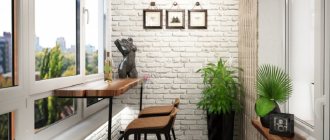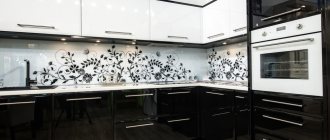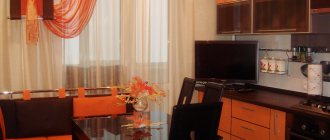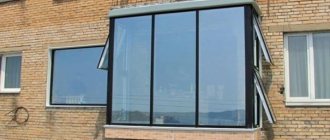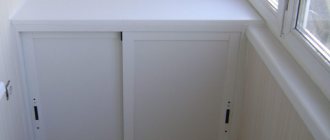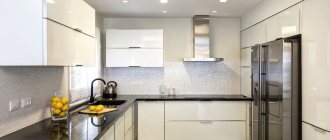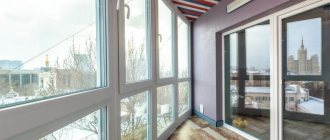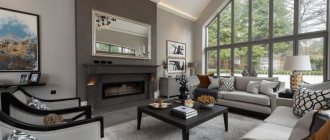How to expand the balcony?
Surely you are planning to glaze your balcony so you can relax on it at any time of the year. And the location of the windows plays an important role. The photo shows that if you take them outside the balcony and remove them as much as possible, the area will increase. So turn to a glazing specialist for help. They will construct the frame necessary for the glazing and install the frames with glass.
Color spectrum
On the topic of Balconies 60 photos If you study the photos posted in interior design magazines, you can understand that color plays a very important role in design development, as it can help make some imperfections invisible. If the balcony is small and narrow, then use light colors, they reflect light and visually expand the space. It is best to give preference to soft and delicate pastel colors, such as peach, beige, milky, light yellow. If the balcony is poorly lit, then choose warm shades (they are listed above). If there is enough or too much light, then cool tones such as lilac, blue or gray will allow you to dim it slightly.
Avoid colors that are too bright; they are too heavy and can be annoying. Although some will add richness and freshness to the interior. Try using orange, mint, yellow, lime, coral. It’s better not to choose dark colors; they will absorb heat and light and make the balcony too hot and even cramped.
Finishing a narrow balcony
The photo shows that finishing materials can also visually expand the space and make the balcony more comfortable. The ideal option for finishing a balcony would be to use plastic panels. It is practical, stylish and reliable. And if you choose something original, the design will also be unusual. Such panels are suitable for both wall decoration and ceiling decoration. The floor can also be plastic, but you can use linoleum, cork panels, laminate or even parquet instead.
Glazed balcony
The territory allows for the implementation of many interesting ideas. To use the glazed room all year round, hanging batteries are installed and insulation is carried out (internal or external). The intended purpose of such an area is always easy to change by replacing furniture, decoration, and decor.
Rough and decorative finishing materials
The finishing must meet the requirements:
- resistance to sunlight, frost, moisture and temperature changes
- environmental cleanliness,
- good thermal conductivity,
- long service life.
General requests for building materials are as follows:
- Use insulation - mineral or stone wool, as well as waterproofing.
- The type of decorative cladding should be combined with the style of the home and not stand out from the outside from the overall architecture of the building.
- On the street side, siding or corrugated sheeting is often used as finishing. But the latter weakly muffles the noise of the rain.
- They can also be finished with wood, having previously treated it with protective impregnations.
Since the interior of the balcony in the apartment is isolated from precipitation, the interior finishing options are more varied:
- Plaster (gypsum, polymer or marble).
Finish the walls and ceiling. There are many color options and their combinations. The material is pliable for creating patterns. The plaster shimmers beautifully in the sun, does not require special care, and retains its color saturation for many years.
- Ceramic tiles or porcelain stoneware.
Many modern collections include frieze, decor, panels, and images. Finished surfaces are easy to clean from dirt and are resistant to abrasion, but do not retain heat.
- Tree.
The walls, floor, and ceiling are finished with wooden clapboard. The width of the slats varies; the color depends not only on the type of wood, but also on the varnish. The material looks presentable, and a pleasant aroma reigns in the room. But don't forget to apply protective impregnation.
- Plastic.
The walls are finished with ordinary lining, and the ceiling is finished with seamless lining. Wide selection of colors and textures. Does not require special care, is easy to clean, does not deform, and is resistant to moisture.
Ideas for arranging large and medium-sized balconies
Balconies are considered large if their area exceeds 5–6 m in length, the average area is 4 m in length. The width can reach 2 m.
The design of the balcony can be adapted to the following functional features:
Study
A compact computer desk and chair are placed near the left or right wall. Above the table there are shelves on which books and other things are placed. On the table there is a compact table lamp and a flat-panel monitor. If space allows, place a sofa under the window area. Near the opposite wall is a bookshelf or cabinet.
The windows have vertical or horizontal blinds. They effectively protect from the sun and are easy to care for.
Don't forget about the decor. Small paintings depicting the city will fit optimally into the office on the balcony. If there is a window sill from the entrance to the room from the balcony, place low plants on it - cyclamen, violets, epipremnum.
Winter Garden
If the room is warm in winter, the plants will smell fragrant all year round. Use vertical and horizontal gardening methods. The first option involves placing plants on wall hanging structures, as well as a phytopan or phytowall. The second method is to place flowerpots on horizontal surfaces – window sills, shelves, racks.
Larger plants are placed on the floor. Set aside space for a compact chair or sofa, as well as a table, so you can admire the beauty of the flora.
Pantry
A good option for medium-sized balconies. However, it is meant that not the entire area is allocated for storage, but only partially. Shelves or cabinets are mounted along the left and right walls, or even better - wardrobes for storing things (out-of-season clothes, current wardrobe, things for active and passive recreation).
The rest of the room is used as a regular balcony. You can use a high folding chair as furniture. The wide window sill is used as a table and/or a place for flowerpots.
Rest and relaxation area
The design of balconies and loggias can also be adapted to create a cozy corner for relaxation. A key piece of furniture is a cozy daybed with soft cushions, a hammock, a rocking chair or a hanging chair. In addition to ceiling lighting, a floor lamp is used. Above the couch (chair) there is a hanging shelf with your favorite literature. Near one of the side walls is a tall bookcase. There is a small coffee table under the window area.
The color scheme is desaturated and calm. The decor is associated with rest and relaxation. Use candle holders with colorful candles. Paintings with subjects that evoke positive emotions - landscapes, flowers, kind fairy-tale characters.
Own cafe-bar
An excellent solution for young and active people. A long tabletop is mounted under the windows, near which high bar stools are placed. Near one of the side walls there is a place to store alcoholic beverages, as well as glasses. You can place a low hookah on the tabletop. The lighting is spotty and dim, and the windows are large and panoramic.
Gym
The idea is being implemented over large areas, as space is needed for exercise equipment and other sports attributes. Place exercise equipment at the optimal distance from each other. Designate space for cabinets where you can store dumbbells, jump ropes, and similar items. Since the exercise machines are heavy, consider the permissible weight of the structure.
How to decorate the interior of a small glazed balcony?
The area of small balconies ranges from 2.8 to 3 meters in length and up to 1.2 m in width.
It is advisable not to glaze it, but if you have purchased a secondary home with such an area, spectacular interior design of the balcony is possible in this case as well.
- Make the window sill wider and use it as a table.
- Place folding, high chairs that can be removed at any time. Other furniture is not practical.
- It is better to abandon the racks and replace them with one compact shelf.
The basic rule for creating the interior of a small balcony is a minimum of items - more space.
- If the windowsill is not wide, place low plants on it.
- If desired, you can place a compact chair near one of the side walls.
- Hang light, light tulle on the windows.
You can visually enlarge the space if the decorative finishing is in light colors. On one of the walls there is a photo wallpaper with a perspective (a horizon going into the distance, a path). The finishing material will “raise” the ceiling not only in a light color, but also with a glossy shine - a suspended structure, white seamless lining.
How to choose and place furniture?
In the photo you can see that the balcony can have almost any purpose. And the choice and placement of furniture will depend on the goals of the owner and the functions of the room.
Interesting options:
- Balcony - dressing room. It must certainly have a spacious closet, a pouf and a large mirror. It is best to place the cabinet against one of the narrow walls, occupying it completely. Place a large mirror on the opposite side. It will allow you to bring the opposite wall closer and visually expand the room.
- Balcony-office. In such a room you can immerse yourself in your work entirely and not be distracted by anything. Place a table and chair against one wall. On the other side there can be a cabinet or a wide and tall rack with books and documents.
- Rest zone. You can place a TV on one of the narrow walls. You can hang several shelves under it, placing books and magazines on them. Place a compact sofa on the other side.
- A place to think and dream. Stretch a comfortable hammock from one long wall to another. Place a shelf behind it. On the other side you can put a cabinet or hang shelves.
Photo of a large balcony
Read here Balcony shelving: 124 photos of smart use of free space on the balcony
Did you like the article? Share 
Style
The most successful styles:
- Country. This direction assumes simple furniture, laconic and rough finishing, the presence of textiles, light colors.
- Mediterranean style. You can use wicker furniture, unusual accessories (for example, forged lamps), natural or simple finishing materials (stone or wood), and pastel shades.
- Japanese style involves the use of deep colors, simple furniture, and bamboo fabrics. Minimalism is encouraged in everything.
- Sea style. Use antique or wicker furniture, shades of blue, blue and white, textiles and themed accessories.
Accessories
To decorate the balcony, you can use any flowers, including fresh ones, especially climbing ones, which can completely occupy one of the walls (preferably a narrow one). You can also choose paintings or panels. It is recommended to place them on narrow walls. If you choose the long side, then place a vertical accessory on it. You can place unusual figurines and family photos on the shelves.
Make your balcony spacious, cozy and functional!
Finishing materials
The choice of design, decor and style is one thing. All this is realized with the help of finishing materials.
Different solutions:
- Color spectrum . Sometimes the shades can be the most unexpected. For example, sometimes the forcing is repainted in a rich color. Such a balcony pleases the eye and adds color to everyday life.
- Monochrome panels are not the most boring option. The lack of colors is compensated by the difference in textures. In some places there are sloppy strokes, in others there are empty panels.
- Unusual materials . Corrugated sheeting is usually not used for the interior, but for the exterior. Wall material marked C is suitable for work - it has a low corrugation height, so it does not take up much space.
- Boards . The walls of the balcony can be covered with larch and covered with transparent varnish - this will protect the surface and it will look natural longer. The edged board is wider than the carriage panel, so the wall will not look so standard.
- Volumetric panels . Such a coating may not be suitable for covering the entire area of the balcony - it will be more beautiful to lay out a small part. You can buy ready-made panels with relief or make them yourself from plaster - it all depends on the skills of the owner.
- Light-dark . The balcony, decorated with ebony-tinted clapboard, looks a little gloomy. It is much more pleasant to combine dark wood and white panels. Ceiling beams fit well into a chalet or country style design.
- Cork finish . This coating is not afraid of moisture, does not rot, protects walls from mold, and retains heat on the balcony. Installation of cork material is easier than standard panels or lining.
- Painted plaster . The walls of the balcony are covered with a dry mixture in combination with PVA glue using strokes (careless application by hand). The top can be painted with matte washable paint.
- Drywall . The material allows you to achieve evenness of the walls - they are ready for painting or wallpapering. However, drywall takes up a small part of the usable space - the profile “eats” about 5 cm of the wall thickness.
- Striped dyeing . Standard masking tape will do the job. The method allows not only to form the simplest straight lines (vertical or horizontal), but also complex patterns or designs.
- Pollock . Standard panels may seem too boring. They can be painted using different styles. One option is the style of abstract artist Jackson Pollock. Splashing paint is considered a fun and interesting activity, especially for children.
- Wallpaper and photo wallpaper . For an insulated and glazed room, any non-paper models are suitable. The main thing is that the walls are level or drywall is installed on them. Photo wallpapers create a whole landscape. However, it is important to protect them from drafts and direct exposure to the sun - otherwise, over time they will peel off and the picture will fade.
- Linkrust and paint . This material is very similar to wallpaper, but has a noticeable texture and is highly resistant to wear. For expressiveness, linkrust is sometimes painted - this emphasizes the texture and adds individuality.
- Imitation of stonework . Real stone will be too expensive for finishing a balcony. It can be replaced using panels or special tiles that imitate coating. This will be cheaper and more practical - any area can be easily replaced if it loses its appearance over the years.
- Clinker tiles . The material is well suited for the Russian climate - especially in the case of frost-resistant balconies. Its surface is characterized by low moisture absorption, so the tiles do not crack or deteriorate for many years.
- Decorative plaster . Using the material, you can create a beautiful room with little cost and effort. In addition, this option gives the surface an unusual texture. A special advantage of plaster is the individuality of the texture, the pattern is unique.
- Bare concrete . The walls can be left in their standard form: just cover them with a whitewash solution to tidy them up and give them a touch of whiteness. An alternative to this solution can be large panels “like concrete” - this is in case the houses are not in the best condition and the coating requires treatment.
- Mosaic drawing . The remains of tiles used for renovation in other rooms or purchased from a construction site can be assembled into a mosaic picture on one of the walls of the loggia. It looks interesting and individual.
- Carpets and fabric on the walls . The dimensions of any loggia allow it to be converted into a hookah room. You don’t have to try too hard to decorate the walls—carpets can be hung on them. A gray balcony can be decorated with cut fabrics or special curtains. The advantage of this solution is that the design of a 2 sq. m balcony can be changed in color at least every week.
- Sofa, lawn, moss . A sofa back will also come into play. The element can only be obtained to order or if you make it yourself. However, it will look fresh and cozy. If you want more greenery, but don’t have time to grow a garden and flowers, then the walls can be decorated with artificial turf. It will grow, reaching the ceiling - installation is simple. As an alternative to lawn, stabilized moss is suitable. It is not suitable for walking, but will serve perfectly for decorating corner areas and walls.
Combinations of styles, colors and materials are limited only by the imagination of the apartment owner. A narrow balcony can be designed to suit any area - you just need to approach the task with enthusiasm and intelligence, and then everything will work out.
